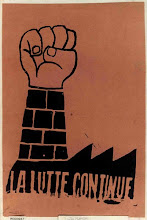 Iran: a new left is emerging on the campuses
Iran: a new left is emerging on the campusesThere have been major confrontations over the last month between students and Iranian security forces. Iranian socialist Behzad of the Iranian Marxist journal Saamaan No (New Order) spoke to Socialist Worker about the new left wing movement rising in Iranian universities.
‘For students in Iran 7 December is an important date. It was on this day in 1953 that students staged mass protests in the University of Tehran at the visit of then US vice-president Richard Nixon.
Nixon was visiting the Shah (the king of Iran) to congratulate him on the coup that toppled the popular nationalist government of Mohammed Mossadeq.
This was a US and British backed coup, and although they got rid of Mossadeq, it did not crush the movement that brought him to power.
The Shah’s security forces fired on the student demonstration, killing three. Since then this date has became a celebration of resistance to dictatorship and the struggle for freedom.
Following the 1953 protests, Iranian students formed the Confederation of Iranian Students to oppose the Shah. Many activists in the confederation were socialist and participated in the revolution that overthrew the Shah in 1979.
Also among them were Islamist students who were part of the National Front – a movement inspired by Mossadeq focused on nationalising Iran’s oil.
Revolution
This movement came to an end when universities were closed for two years following the foundation of the Islamic Republic and the rise to power of Ayatollah Khomeni.
These were the years of the Iran-Iraq war and terrible repression. Many tens of thousands were killed or put in prison. The left was defeated.
In the early 1990s a reform movement grew in Iran. It brought to power the “reformist” president Mohammad Khatami. This movement emerged at the same time as the Soviet Union collapsed. So the left was in disarray and dominated by ideas that said there can never be revolutionary change, the best you can hope for are gradual reforms. This movement put all its faith in Khatami.
However, as it became clear that the reformist president could not deliver the changes demanded of him, this created the conditions for a new left to emerge.
One of the centres of this movement was the pro-reform student Islamist societies in the colleges. At the time these were small groups calling for democracy. They did not describe themselves as socialist or left wing.
They put their faith in small changes that would bring greater freedom and democratic rights, a free press and so on. These students became radicalised following the failure of the reform movement, and the closure of Salam, a pro-reform newspaper. Their protests were heavily attacked by the security forces. Some students began to break with the fundamentalist ideology and question reformism and the state.
Gradually through studying the history of the labour movement in Iran and internationally, they began to develop Marxist ideas. They began to organise and publish newspapers, blogs and other literature. They debated everything from art to politics.
Demands
Their demands range from improving conditions in universities through to questions of democracy. And the opposition to neoliberal policies of the government has also tapped into wider discontent across the country.
At the same time as a growing radicalisation among students there was a rise in workers’ struggles in Iran. At the heart of this were bus drivers, who established an independent trade union and found themselves in opposition to the state.
The majority of Iran’s 70 million people are under 35. There are over four million students in the country.
Two years ago, left wing students joined with reformists and the Islamic student societies to organise a major celebration of the events of 7 December 1953.
A year later these students began to raise slogans calling for socialism. They could not march in the streets, but they had good mobilisations on campus. The state responded with waves of arrests and repression.
In the first wave 30 left wing students were seized, in the second 11 – one of whom was killed. These arrests galvanised other students into protest behind student action committees.
Since then we have seen a massive growth in the socialist student societies. There are now up to 15 left wing journals and newspapers – most of which are clandestine.
These students have been debating two major political questions. The first is the opposition to imperialism, especially the threats from the US following the invasion of Afghanistan and Iraq.
The second is how to achieve real change inside Iran. They see these two positions as being important for the movement for change.
The right inside Iran has been able to use the threat of imperialism to snuff out any opposition at home. The first time was when the US supported Iraq during its war with Iran (1980-88) and now following the US invasions of Afghanistan and Iraq, and Israel’s war on Lebanon in the summer of 2006.
Last month there were major confrontations between students and security forces. At the same time there have been strikes and other protests. The re-emergence of the student movement and left wing ideas on campus is a sign of a growing confidence and changes that are developing inside Iran.’
Join the picket to support Iranian students this Saturday 16 February, 12 noon, Trafalgar Square. For more Information about those students go to » www.13azar.blogspot.com
लिंक:http://www.socialistworker.co.uk/art.php?id=14134












No comments:
Post a Comment